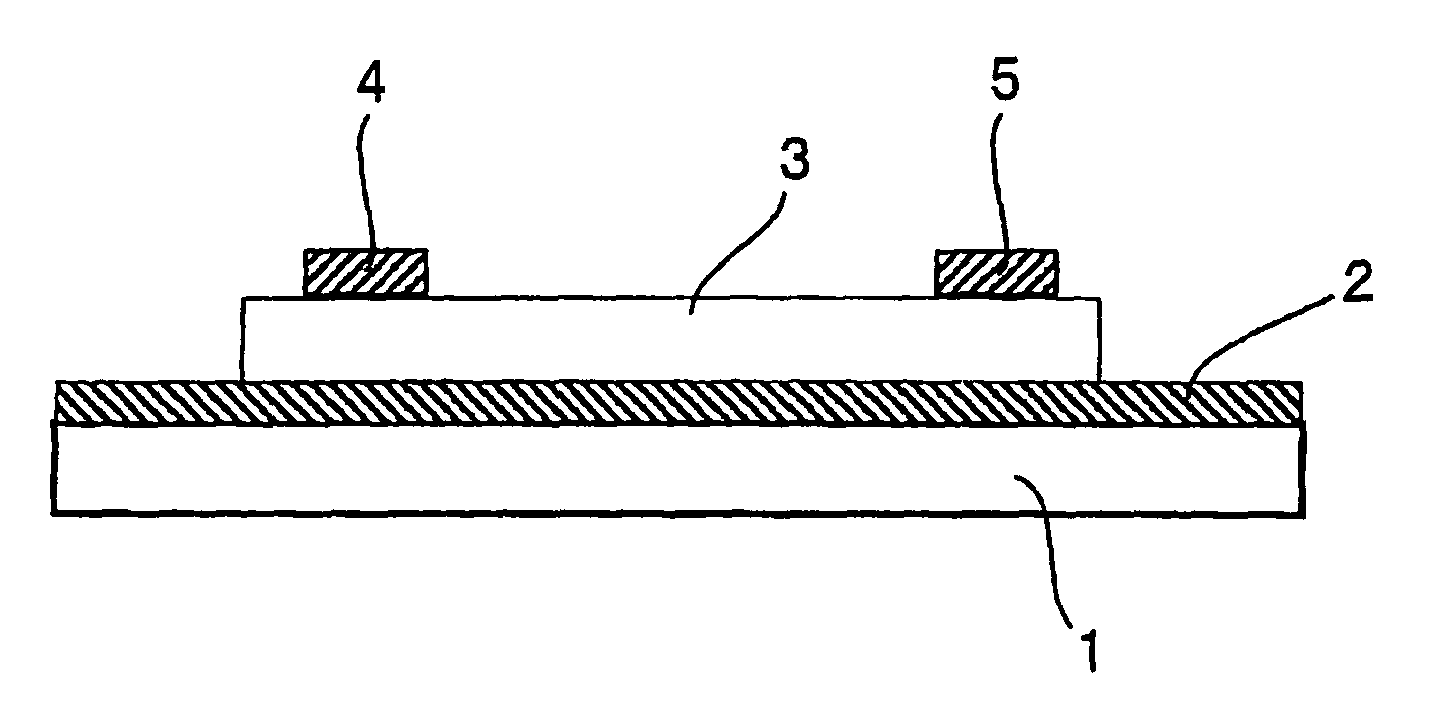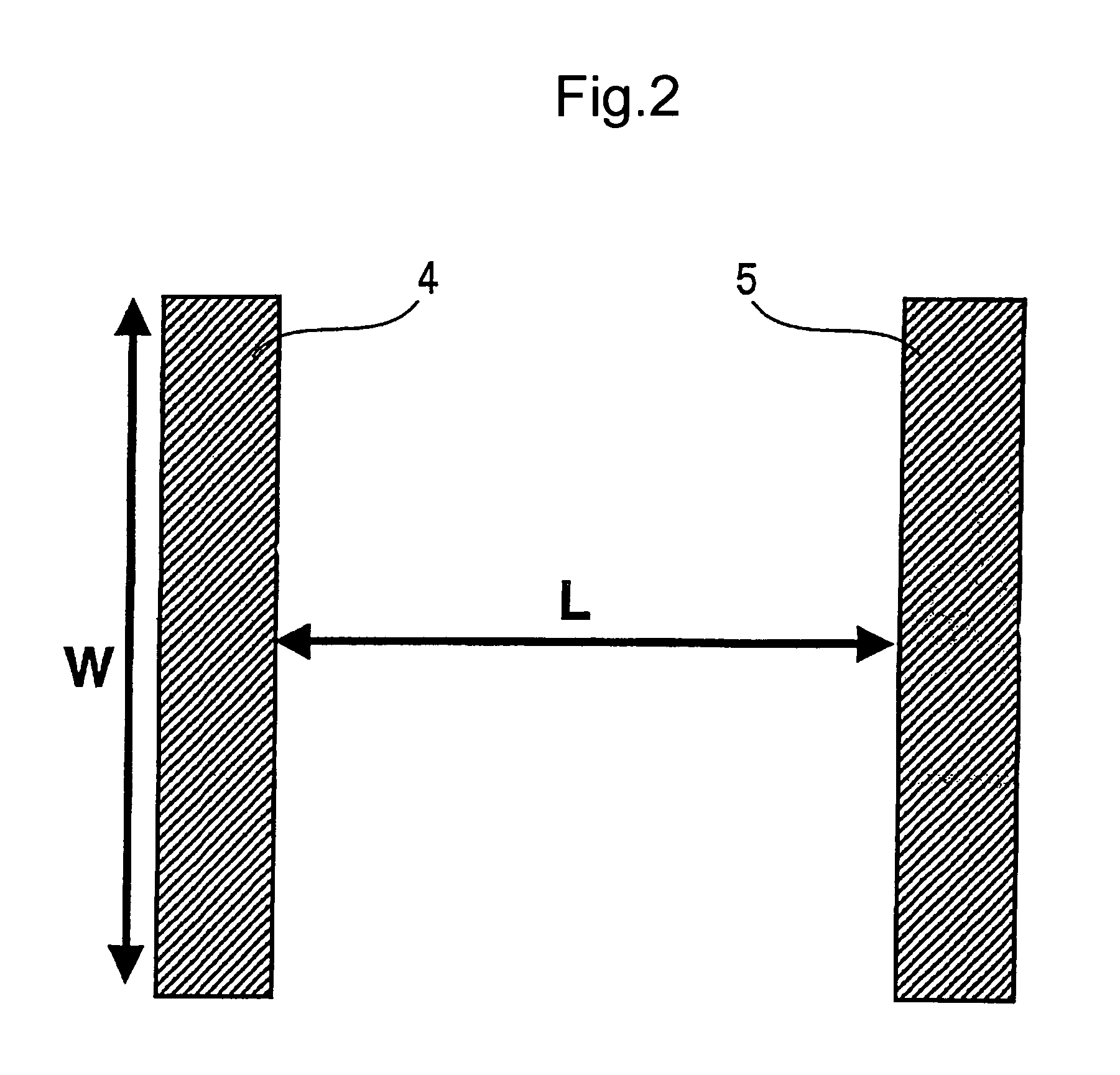Organic semiconductor material and organic transistor using the same
a technology of organic semiconductors and semiconductor materials, applied in the direction of non-metal conductors, conductors, thermoelectric devices, etc., can solve the problems of insufficient carrier mobility of such a conventional organic semiconductor material, and achieve the effects of high carrier mobility, superior controllability of threshold voltage, and high on/off ratio
- Summary
- Abstract
- Description
- Claims
- Application Information
AI Technical Summary
Benefits of technology
Problems solved by technology
Method used
Image
Examples
embodiment 2
Synthesis of Embodiment 2
9-n butyl-3,6-di(5″″-n-hexyl-pentathiophene-2-yl)carbazole [Compound 2]
[0063]
[0064]In a dry closed reaction chamber provided with a mechanical agitator and nitrogen / vacuum inlets connected to a nitrogen line and a vacuum line, add 9-buthyl-3,6-dibromocarbazole (189.5 mg, 0.5 mmol), 5,5′-di(4,4,5,5-tetramethyl-1,3,2-dioxaborolan-2-yl)-2,2′-bithiophene (418 mg, 1 mmol), Suzuki coupling catalyst, 5 ml of toluene and 8 ml of a base solution for reaction. The temperature of the reaction chamber is increased to 95 degree / C. after repeating for three times a decompression-nitrogen substitution operation. The reaction is performed for approximately 4 hours at 95 degree / C. under a nitrogen atmosphere. Next, add 2,5-diiode thiophene (336 mg, 1 mmol) and continue the reaction for three more hours at 95 degree / C. under a nitrogen atmosphere. Thereafter, add 5-(4,4,5,5-tetramethyl-1,3,2-dioxaborolan-2-yl)-5′-n-hexyl-2,2′-bithiophene (414 mg, 1.1 mmol) and further continu...
embodiment 3
Synthesis of Embodiment 3
Methyl-[4,4′-di(5″″-n-hexyl-pentathiophene-2-yl)triphenylsilane [Compound 3]
[0066]
[0067]Add methyl-4,4′-dibromotriphenylsilane (216 mg, 0.5 mmol), 5,5′-di(4,4,5,5-tetramethyl-1,3,2,-dioxaborolan-2-yl)-2,2′-bithiophene (418 mg, 1 mmol), Suzuki coupling catalyst, 5 ml of toluene and 8 ml of a base solution for reaction. The temperature of the reaction chamber is increased to 95 degree / C. after repeating for three times a decompression-nitrogen substitution operation. The reaction is performed for approximately 4 hours at 95 degree / C. under a nitrogen atmosphere. Next, add 2,5-diiode thiophene (336 mg, 1 mmol) and continue the reaction for three more hours at 95 degree / C. under a nitrogen atmosphere. Thereafter, add 5-(4,4,5,5-tetramethyl-1,3,2-dioxaborolan-2-yl)-5′-n-hexyl-2,2′-bithiophene (414 mg, 1.1 mmol) and further continue the reaction for three more hours at 95 degree / C. under a nitrogen atmosphere.
[0068]After cooling the product, drop into 200 ml of me...
embodiment 4
Synthesis of Embodiment 4
4,4′-di(5″″-n-hexyl-pentathiophene-2-yl)stilbene [Compound 4]
[0069]
[0070]Add 4,4′-dibromostilbene (169 mg, 0.5 mmol), 5,5′-di(4,4,5,5-tetramethyl-1,3,2,-dioxaborolan-2-yl)-2,2′-bithiophene (418 mg, 1 mmol), Suzuki coupling catalyst, 5 ml of toluene and 8 ml of a base solution for reaction. The temperature of the reaction chamber is increased to 95 degree / C. after repeating for three times a decompression-nitrogen substitution operation. The reaction is performed for approximately 4 hours at 95 degree / C. under a nitrogen atmosphere. Next, add 2,5-diiode thiophene (336 mg, 1 mmol) and continue the reaction for three more hours at 95 degree / C. under a nitrogen atmosphere. Thereafter, add 5-(4,4,5,5-tetramethyl-1,3,2-dioxaborolan-2-yl)-5′-n-hexyl-2,2′-bithiophene (414 mg, 1.1 mmol) and further continue the reaction for three more hours at 95 degree / C. under a nitrogen atmosphere.
[0071]After cooling the product, drop into 200 ml of methanol to precipitate the pro...
PUM
| Property | Measurement | Unit |
|---|---|---|
| reaction time | aaaaa | aaaaa |
| thickness | aaaaa | aaaaa |
| thickness | aaaaa | aaaaa |
Abstract
Description
Claims
Application Information
 Login to View More
Login to View More - R&D
- Intellectual Property
- Life Sciences
- Materials
- Tech Scout
- Unparalleled Data Quality
- Higher Quality Content
- 60% Fewer Hallucinations
Browse by: Latest US Patents, China's latest patents, Technical Efficacy Thesaurus, Application Domain, Technology Topic, Popular Technical Reports.
© 2025 PatSnap. All rights reserved.Legal|Privacy policy|Modern Slavery Act Transparency Statement|Sitemap|About US| Contact US: help@patsnap.com



